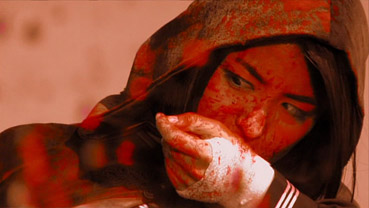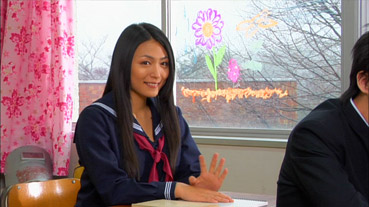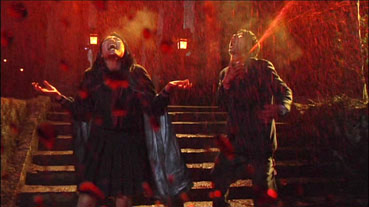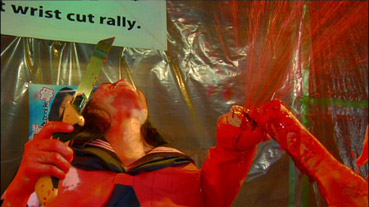"I get to cut up her body! Every father dreams of this!" |
Vice Principal Furano Kenji following the death of his daughter |
If you're new to the world of modern Japanese pop gore horror then Nishimura Yoshihiro and Tomomatsu Naoyuki's deranged and blood-soaked Vampire Girl vs. Frankenstein Girl [Kyûketsu Shôjo tai Shôjo Furanken] is likely to come as a jolt. It does have the good grace to lay its cards on the table in the opening scene, as the Vampire Girl of the title, injured and accompanied by her boyfriend, is confronted by three head-twisting humanoid female creatures and proceeds to rip them to pieces. It's not what she does but how she does it that's likely to startle the uninitiated, transforming her own blood into crystallised swords, then ripping the skin from the head of the first creature like she's peeling an orange at high speed, sending its skull spinning towards the face of its companion, which it bites, rips and spews a fountain of blood over. That the skulls of all three creatures land on top of each other with comical clonk reminds us that we're not meant to be taking this too seriously, as if the rock 'n' roll presentation wasn't clue enough.

This is not the story's start but a point to look back from to relate how Vampire Girl, a sweet-looking schoolgirl named Monami, came to hook up with shy boyfriend Jyugon and be pursued by the eponymous Frankenstein Girl. All three share a class that differs somewhat from the standard image of ordered and well behaved Japanese schools and is populated by a diverse collection of trend-driven cliques, from the punk lolitas to the ganguro girls.
Ah yes, the ganguro girls. You may be OK with the cartoon violence and blood-letting, but you'll still likely have a few problems with the ganguro girls, at least as they are presented here. Ganguro, it's worth noting, is a real Japanese fashion whose young female followers blacken their faces and wear light coloured make-up to create a look that's not too distantly removed from those TV minstrels we happily bid goodbye to all those years ago. But that's not enough for these girls, who up the image a notch with facial prosthetics that transform them into plate-lipped tribeswomen and adorn their leader with the sort of flat wide nose and oversized lips you'd only expect to see nowadays in a fascist cartoon. Satire is clearly intended here, but it frankly doesn't translate. Mind you, given the very real problem of suicide and self-harm amongst high school students in modern Japan, the group who meet to cheerfully slash at their wrists also unashamedly flies in the face of taboo and good taste.
Narrating the story is the meek-mannered Jyugon, who's been selected by goth clique leader Keiko to serve as her boyfriend, something he's agreed to more out of fear than desire. But sweet new transfer student Monami also has her eyes on this nervous young man, and declares her interest by presenting him with a valentine chocolate made from own blood, the first part of her plan to turn him into a vampire like her. Well, not quite like her, as it turns out. Down the school basement, meanwhile, Keiko's science teacher father Furano Kenji is experimenting with reanimating dead tissue and not having much luck. This all changes when a drop of Monami's blood comes into his possession, a liquid so potent it can even bring wood screws to life. When Keiko is killed after falling off a roof, he reconstructs her from the body parts of clique leaders killed by the school's oversexed nurse Midori, who assists his experiments, and sends the resurrected Keiko off to do combat with Monami.

It's no real surprise that Tomomatsu's screenplay was based on a manga comic, one written by actress and writer Uchida Shungiku, who recently appeared in Tsukamoto Shinya's Nightmare Detective 2 [Akumu Tantei 2], which along with its predecessor still hasn't had a UK release on any format. Sorry, but that still irks me. Realism and restraint thus have little place here, as Vampire Girl is essentially a live action horror cartoon for the MTV age, a post-modern whirl of cinematic techniques in which whole sequences play out like blood-spattered, semi-psychedelic music videos.
While this may make the whole enterprise sound shallow and vacuous, it fails to take into account the energy and wit with which the whole caboodle is handled. A key factor is Monami herself, who despite having been around for centuries has settled on the personality of a chirpy schoolgirl, which she only lets slip when engaging in combat. This does put a consistently amusing spin on the familiar figure of the predatory vampire, as she politely greets one victim, flashes a cute smile, and then transforms her face into a giant carnivorous mouth to devour him, presenting his bloodied camera to Jyugon as evidence of her actions like an innocent child handing over a birthday present. Nothing is presented straightforwardly if the filmmakers can devise a grotesque or surreal alternative. Thus severed legs are turned into a propeller for levitation, a wrist-cutting contest is lost when the over-enthusiastic candidate severs her arm, and Furano conducts his reanimation experiments as a kabuki performance in full costume and make-up, using screws and power tools to assemble the limbs into a creature more in-keeping with the work of Jan Švankmajer than Mary Shelley.
Vampire lore is messed with and sometimes disregarded, a passing comment about being a bit bothered by daylight being the nearest Monami comes to harm from the sun's rays. Religion too plays no part in the proceedings, though is amusingly referenced by the gigantic crucifix to which the kidnapped Jyugon is tied and which is later transformed into a makeshift ledge (don't ask) that contributes to the vampire's salvation. There are a number of oblique and possibly unintentional references to other film and literary works, from The Nutty Professor to the notorious drug-fuelled weekend in which Percy Shelley thought his wife Mary had eyes in place of her nipples (that this was the same Mary Shelley who wrote Frankenstein as a consequence of their adventures is surely no coincidence). But my absolute favourite sees Monami rip open a man's jugular vein and dance in ecstatic slow motion in a rain of his erupting blood, a sequence that plays like a dark inversion of Winona Ryder's snow dancing scene in Edward Scissorhands.

Given its ability to make even the most outlandishly unlikely look plausibly real, it comes as no surprise that CGI is gleefully employed at every opportunity, often to deliberately grotesque or amusing effect, as with Monami's face-to-giant-mouth transformation, the blood spot that Midori chases around the floor with a mop, or Monami's ability to fashion her own blood into swords, wheels, bullets and even a Spider Man-style thread. A couple of smart ideas fall victim to the overriding style, with the eerie effectiveness of pedestrians as walking blood vessels quickly lost as they become part of an impromptu hallucinogenic rock video. That's not to knock a music score that's sometimes as witty as the visuals, particularly when used to counterpoint the imagery – the cheery pop tune that accompanies Monami's blood rain dance really is the icing on that particular cake.
Vampire Girl vs. Frankenstein Girl is a work of controlled creative madness, a live-action manga whose makers have been let loose in the cinematic toy box and allowed to run riot. It's frequently excessive and occasionally immature (the racial stereotyping is way too crude to ignore), but it's also bristling with energy and wildly inventive, and if you can take the over-the-top violence and gore, it's a great deal of amoral fun.
A clean and detailed 1.78:1 anamorphic transfer whose contrast and colour accuracy are hard to properly judge due to the games played with both in almost every shot in the film. It all certainly feels true to intentions – there are no problems with episodes of extreme tinting and the brighter colours are appropriately vivid. Especially red.
A Dolby 2.0 stereo track only, but a clear and sprightly one that does particularly well by the exaggerated sound effects and lively music.

A special mention should also go to the subtitles, which are slightly smaller than average but still clearly legible and appear to be largely accurate in their translation. Where they really stand out is in the intermittent appearance of a second, top-of-screen sub to briefly explain cultural points that a western viewer might not be familiar with but which they need to know about to understand what follows. It might be nice to have the option to switch this on and off, but I still applaud its inclusion.
The supplied screener only had the original Japanese trailer (1:08), an almost random assembly of shots from the film cut to a very loud rock track. Some on-line sites have listed a making-of documentary and star stage greetings as additional extras, but I've yet to confirm whether they are actually present – neither are listed on the BBFC web site as having been submitted for classification.
An imaginative, energetic and no-holds-barred melding of manga, horror and pop video sensibilities into a supremely violent but consistently inventive live-action cartoon. The racist presentation of the ganguro girls I could live without (I just wish the filmmakers had used just an ounce of the smarts they show elsewhere when designing the girls' appearance), but the rest is an absolute blast, and the cultural trivia subtitles are a first rate idea I'd like to see employed elsewhere. Recommended, but with the above provisos.
|